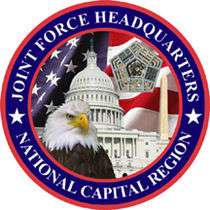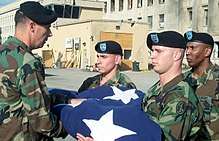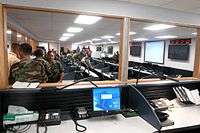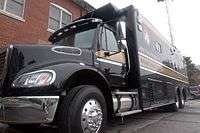Joint Force Headquarters National Capital Region
| Joint Force Headquarters National Capital Region | |
|---|---|
 Official seal of Joint Force Headquarters National Capital Region | |
| Active | 2004 - Present |
| Country | United States |
| Branch | Joint |
| Type | All |
| Role | Homeland defense |
| Part of | United States Northern Command |
| Garrison/HQ | Fort Lesley J. McNair, Washington, D.C. SW |
| Anniversaries | Activation: September 22, 2004 |
| Commanders | |
| Current commander | MG Michael L. Howard, USA |
| Notable commanders |
MG Galen B. Jackman, USA MG Guy C. Swan III, USA |
Joint Force Headquarters National Capital Region (JFHQ-NCR) is directly responsible for the homeland security and defense of the Washington D.C. area as well as surrounding counties in Virginia and Maryland. Primarily made up of joint military units within the National Capital Region, the JFHQ-NCR assists federal and local civilian agencies and disaster response teams in the event that the capital area's security is or possibly could be breached by acts of terrorism. Officially activated on September 22, 2004, JFHQ-NCR is part of United States Northern Command.
History

After the terrorist attacks on the World Trade Center and The Pentagon on September 11, 2001, military and civilian leaders recognized a need for strong cooperation and communication between agencies and national and local units in times of emergency or to prevent such attacks in the first place, something that had been severely lacking prior to that time. USNORTHCOM was subsequently established, taking the lead of several JTFs throughout the U.S. that are subordinate to the Command and charged with homeland security. The Joint Force Headquarters for the National Capital Region was created for the sole purpose of preventing and responding to future terrorist attacks within the Washington, D.C. area and its surrounding cities and counties.
JFHQ-NCR officially came into being in September 2004. However, the unit had been operating in part for at least a year prior to its official creation. Major General James T. Jackson, the Military District of Washington (MDW) Commander at the time of the September 11th attacks, was the first to take hold of the concept of the new Headquarters and began to piece various aspects of it together, particularly seeing and responding to the need for a mobile command center and a more effective central command and control headquarters. When MG Galen B. Jackman replaced Jackson in 2003, Jackman solidified the role of JFHQ, commanding the response to various regional emergencies and National Special Security Events (NSSE), proving the potential of JFHQ-NCR. When the organization finally stood up in the fall of 2004—after having had a year of practice—it was fully operational and able to provide an effective answer to the NCR's growing security concerns.[1]
JFHQ-NCR in action

When called upon to assist in a regional crisis or an NSSE (national events requiring security measures outlined and directed by the U.S. Secret Service), the JFHQ mobilizes and becomes Joint Task Force-National Capital Region (JTF-NCR). The JTF-NCR is then directed to respond as quickly as possible and with as many component partners as applicable to address the issue at hand. Although the JFHQ is the single point of contact for entities within the JTF-NCR, the JTF is ultimately guided by the lead agency (the agency that asked JFHQ for assistance to begin with) and the directives of USNORTHCOM.
The JFHQ-NCR has had several claims of success in the few years it has been operating. The first crisis that required the help of the JFHQ's JTF occurred on February 2, 2004 when ricin was discovered in the Capitol Hill office mail room of Senate Majority Leader Bill Frist. The Marine Corps' Chemical Biological Incident Response Force (CBIRF) assisted in the situation and helped officials safely decontaminate the area.[2]
Other JTFs have been activated in the NCR for the dedication of the World War II Memorial on the National Mall and its accompanying World War II reunion, former president Ronald Reagan's state funeral, President George W. Bush's 2005 Presidential Inauguration, President Bush's State of the Union Addresses, and most recently the state funeral of former president Gerald Ford.[3][4][5]
Joint Operations Center

The Joint Operations Center (JOC), dedicated a month and a half prior to the official activation of the JFHQ, is the command and control center at the heart of the JFHQ. The JOC is housed in a newly renovated building at Ft. McNair, designed with the latest in technological advances for its time. The JOC boasts 50+ work stations, complete with secure and non-secure capability by way of phones, computer network access, and video teleconferencing for the entire center. The JOC is also "red phone" capable, Geospatial Information System ready, and fully integrated into the secure NORTHCOM communications system. In addition to the ability to communicate with various civilian and military units within the NCR, satellites provide the JOC with secure communication links to the Mobile Command Center and its smaller mobile cousin, "Dagger." [6]
Mobile Command Center

The Mobile Command Center (MCC), like the JOC, was instituted as a direct result of failures in communication capabilities at the time of the September 11th attacks. MG James Jackson needed to be in two places at once much of the time to coordinate recovery efforts at the Pentagon; however, "We had no vehicle then that was capable of anything more than a non-secure telephone connection. The EOC was basically an unclassified environment. (Jackson) made the commitment to secure a modern mobile command center and to fund it from the MDW budget," said Col. Egon Hawrylak (USA-Ret.), a civilian deputy operations officer who previously worked in the MDW operations center.[6]
The MCC, the mobile, smaller version of the JOC, is situated on a 41-foot, 10-wheeled, truck chassis. The MCC was custom built for its mission of providing mobile support to the JFHQ commander and the JOC and, like the JOC, is complete with the latest in computer, technological, and communication advances.
Organization
Command of the JFHQ-NCR
The commanding officer of the JFHQ-NCR is also the Commanding General of the Army's MDW. This general officer, who represents the US Army within JFHQ-NCR through the MDW, is aided by a deputy commanding officer who is not associated with the MDW; he or she is a commanding officer of one of the military component-partners within JFHQ-NCR. The commander of JFHQ-NCR, like all JTFs in the U.S., must answer to USNORTHCOM and its commanding general.[7][8]
| Commander | Deputy Commander | Dates |
|---|---|---|
| Maj. Gen. Michael L. Howard, USA | Rear Adm. Charles W. Rock, USN | 2017–Present |
| Maj. Gen. Bradley A. Becker, USA | Rear Adm. Yancy B. Lindsey, USN | 2015–2017 |
| Maj. Gen. Jeffrey S. Buchanan, USA | Rear Adm. Markham K. Rich, USN | 2013–2015 |
| Maj. Gen. Michael S. Linnington, USA | Rear Adm. Patrick J. Lorge, USN | 2011–2013 |
| Maj. Gen. Karl R. Horst, USA | Rear Adm. Patrick J. Lorge, USN | 2009–2011 |
| Maj. Gen. Richard J. Rowe, Jr., USA | Rear Adm. Earl L. Gay, USN | 2007–2009 |
| Maj. Gen. Guy C. Swan III, USA | Rear Adm. Terence E. McKnight, USN | 2005–2007 |
| Maj. Gen. Galen B. Jackman, USA | Rear Adm. Jan Cody Gaudio, USN | 2004–2005 |
The Command Sergeant Major of the MDW, Command Sergeant Major David O. Turnbull, fills the same position within the JFHQ-NCR.[8] Because of the double-role of the MDW/JFHQ-NCR Commander, both commands are headquartered out of the same address at Ft. Lesley J. McNair, Washington, D.C.
Interagency and community cooperation
When called upon for assistance by the civilian sector of the National Capital Region, the JFHQ-directed-JTF acts as a single cooperative point of contact for a wide range of military units, civilian units, and government agencies throughout the Washington, D.C. area.[9][10]
Military units and assets
- Army Military District of Washington/Joint Force Land Component Commander (JFLCC) (MDW)
- White House Transportation Agency
- 1st Battalion, 3rd U.S. Infantry Regiment
- United States Army Band
- 911th Engineer Company
- 12th Aviation Battalion
- Washington MP Battalion (CID), Fort Myer, Virginia
- 68th MP Detachment (CID), Fort Meade, Maryland
- 75th MP Detachment (CID), Fort Belvoir, Virginia
- Site-R Raven Rock Mountain Complex Alternate Joint Communications Center (AJCC) Alternate National Military Command Center[11]
- Naval District Washington (NDW)/Joint Force Maritime Component Commander (JFMCC)
- Air Force District of Washington (AFDW)/Joint Force Air Component Commander (JFACC)
- Marine Corps National Capital Region Command (aka the Marine Corps Installations National Capital Region)
- U.S. Coast Guard Fifth District
On 10 June 2010, Secretary of the Army, John M. McHugh, rescinded MDW's responsibility for the administration and daily operation of Arlington National Cemetery. However, MDW still maintains ceremonial support for funerals and guarding the Tomb of the Unknown Soldier.
When the Joint Forces Headquarters transitions to become Joint Task Force National Capital Region, the 320th Air Expeditionary Wing activates and becomes the Air Force service component of the task force. Normally, the commander of the Air Force District of Washington serves as the commander of the wing.[12]
Military installations
- Fort McNair, Washington, D.C.
- Joint Base Myer-Henderson Hall, Virginia
- Fort Belvoir, Virginia
- Fort A.P. Hill, Virginia
- Fort Meade, Maryland
- Fort Hamilton, New York
Government/intelligence agencies
- USNORTHCOM
- Department of Homeland Security's Office of National Capitol Region Coordination (ONCRC)
- Federal Bureau of Investigation (FBI)
- Joint Terrorism Task Force (JTTF)
- Naval Criminal Investigative Service's Multiple Threat Alert Center (MTAC)
- 902nd Military Intelligence Brigade
- Federal Emergency Management Agency (FEMA)
- U.S. Secret Service
- Federal Aviation Administration
- U.S. Department of Health and Human Services
- Joint Task Force Civil Support (JTF-CS)
- White House Military Office
- D.C./Virginia/Maryland State and National Guard Units
- US Army's Installation Management Agency, Northeast Region Office (IMA-NERO)
- Washington Metropolitan Area Transit Authority
- Washington Headquarters Services
- Pentagon Force Protection Agency
- Walter Reed Army Medical Center
- National Naval Medical Center
Civilian units
References
- ↑ "Capital Region Joint Force Headquarters Readies for Battle" by Tom Mani, "American Forces Press Service" August 5, 2004
- ↑ "Statement of General Ralph E. Eberhart, USAF, Commander North American Aerospace Defense Command and United States Northern Command before the Senate Armed Services Committee," USNORTHCOM's Newsroom, 25 March 2004
- ↑ "Guardians Of The Nation's Capital" Archived 2013-03-29 at the Wayback Machine. by MG Galen B. Jackman, USA, "Army Magazine: The Green Book" Vol. 54, No. 10, October 2004
- ↑ "Safeguarding the Nation's Capital And Providing Ceremonial Support" Archived 2015-09-24 at the Wayback Machine. by MG Guy C. Swan III, USA, "Army Magazine: The Green Book" Vol. 55, No. 10, October 2005
- ↑ "Statement of General Ralph E. Eberhart, USAF, Commander North American Aerospace Defense Command and United States Northern Command before the Senate Armed Services Committee," 25 March 2004
- 1 2 Tom Mani (August 5, 2004). "Capital Region Joint Force Headquarters Readies for Battle". American Forces Press Service. Retrieved 2006-12-02.
- ↑ MDW Homepage/Leadership List Archived 2006-03-05 at the Wayback Machine.
- 1 2 "Leadership List". JFHQ-NCR Homepage. Archived from the original on 2007-03-12. Retrieved 2006-12-02.
- ↑ JFHQ-NCR Partners, Units, and Installations Archived 2007-03-12 at the Wayback Machine.
- ↑ JFHQ-NCR Task Organization Chart Archived 2005-11-08 at the Wayback Machine.
- ↑ "Archived copy". Archived from the original on 2005-02-15. Retrieved 2006-05-29.
- ↑ "Factsheet: Air Force District of Washington". Directorate of Public Affairs, Air Force District of Washington. 2012-12-12. Retrieved March 15, 2014.
External links
- "JFHQ-NCR Homepage". Archived from the original on 2006-06-24.
- "JFHQ-NCR adopts coordinated Strategic Plan". JFHQ-NCR Public Affairs. February 2, 2006.
- "Joint Force Headquarters National Capital Region". www.northcom.mil (US Northern Command). Archived from the original on 2006-04-21.
- Linda Fischer (September 24, 2004). "Joint Force Headquarters-NCR officially stands up". www.dcmilitary.com. Archived from the original on October 10, 2004.
- Jim Garamone (September 22, 2004). "New Joint Command Stands Ready to Defend Capital". www.defenselink.mil.
- Harold Kennedy (June 2005). "Joint Force: Capital Unit Seen as Prototype for Homeland Defense". www.NationalDefenseMagazine.org. Archived from the original on 2007-09-30.
- Tom Mani (August 16, 2005). "Exercise practices response to attack on capital". www.GlobalSecurity.org.
- Tom Mani (February 2, 2006). "JFHQ-NCR backstops presidential message". JFHQ-NCR Public Affairs. Archived from the original on March 16, 2006.
- Katherine McIntire Peters (July 15, 2005). "Guardian General". GovExec.com.
- Beau Whittington (October 7, 2005). "Joint Force structure defined at press briefing". www.dcmilitary.com. Archived from the original on December 27, 2005.